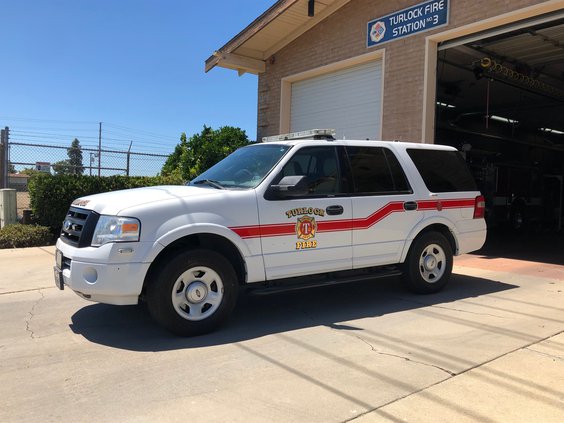Turlock Interim Fire Chief Gary Carlson has unveiled a new plan that will likely keep the department from having to “brown out’ any of the four stations, but will still leave the city short on fire engine coverage.
When staffing is down Carlson is deploying a quick response vehicle staffed with two fire personnel, rather than the three needed for a fire engine, and keeping all fire stations opened. The quick response vehicle is a sports utility vehicle stocked with medical equipment and supplies and will allow the two-person team to respond to medical emergencies, which make up about 65 percent of all the department’s calls. While the team can respond to a fire call, they won’t be able to do anything until a fire engine from one of the other districts arrives.
Before this new plan, the other option was to temporarily close one station for a shift or day and assign any remaining personnel to another station. The fire department operates on a staffing of 13 per shift. Each station is assigned a firefighter, an engineer, and a captain. A battalion chief oversees the four stations for the shift. If, for example, a captain had a scheduled day off, under the previous plan the station would close for that shift and the engineer and firefighter would be assigned to other stations. Under the new plan, the firefighter and the engineer would be assigned to the quick response vehicle and the station would remain open.
“What does make this plan [quick response vehicle] better in my estimation is when there’s a call of a kid that has fallen into a pool, or there’s a baby choking, or some kind of medical emergency,” Carlson said. “I can get two people there that can do the same medical stuff in two minutes versus 10 minutes for the next available engine to get there. That’s the one thing in my mind that I couldn’t get away from.
“A lot of my guys on the crews disagreed and thought I should have gone with the other option,” Carlson said. “I weighed both options and I still just can’t get past that fact in my mind that 65 percent of our calls are medical and if that’s my kid choking, I want someone there in two minutes and not 10.”
Carlson recognizes the plan will have an impact on fighting fires if that first engine has to come from further away.
“A call may come in as a fence fire and now because there’s no engine in that district, the fence fire has caught the grass on fire and now it’s spread to the shed,” Carlson said. “It’s going to take longer to get things done and that’s frustrating for firefighters because they want to get there and do something. But you can only work to your capabilities and the equipment you have. It’s not a great option, but it’s the lesser of two bad options.”
The need to cut expenses comes because the City of Turlock has adopted a balanced budget, which calls for a trim of about $4 million from the various departments.
“Fire is about 25 percent of the general fund budget, so we were tasked with cutting 25 percent of our budget,” Carlson explained. “So, that amounted to a little over $1.1 million dollars. That just changes how we have to do things for the most part. There’s only so much you can cut in supplies. You still have to keep the lights on, put fuel in the engines and all of those things.”
The department was able to save some money by delaying equipment purchases and keeping two already-vacant fire fighter positions unfilled. Division Chief Brian White had announced his retirement as going into effect in July, so the decision was made to keep that administrative role vacant and have the then three remaining administrators absorb his duties. Now, with Talloni’s departure, those duties are being split between Carlson and Fire Marshal Mark Gomez.
“That only got us about half way there, so we had to make some tougher changes,” Carlson said.
In previous years the fire department has had an overtime allotment of $500,000, but this fiscal year will be operating on an overtime budget of $100,000.
“With less personnel total and 80 percent less overtime budget, there’s no way we can maintain the staffing we have every day,” Carlson said.
Carlson explained that he can’t have just two people on an engine, partially for safety concerns, but also because it would violate the department’s standards on most occasions. Within the team, captains and engineers are the more senior members and as such have more time off. Carlson said the department can’t have a firefighter and an engineer or a firefighter and a captain assigned to an engine because it goes against the job descriptions.





